![2026 Market Outlook [PODCAST]](/content/dam/thrivent/fp/fp-insights/advisors-market360-podcast/advisors-market360-podcast-16x9-branding-insights-card.jpg/_jcr_content/renditions/cq5dam.web.1280.1280.jpeg)
2026 Market Outlook [PODCAST]
The markets were strong in 2025. Will this momentum continue through 2026?
The markets were strong in 2025. Will this momentum continue through 2026?
12/16/2025
AUGUST 2025 MARKET UPDATE
08/07/2025

Investors may want to consider rotating from cash to Treasuries and/or corporate bonds.
Thrivent Asset Management contributors to this report: John Groton, Jr., CFA, director of administration and materials & energy research; Matthew Finn, CFA, head of equity mutual funds; and Charles Hofstrom, CFA, investment product manager
S&P 500 Index set 10 record highs in July, but ended the month on a weaker note.
We anticipate market growth will slow, but the economy will avoid a recession.
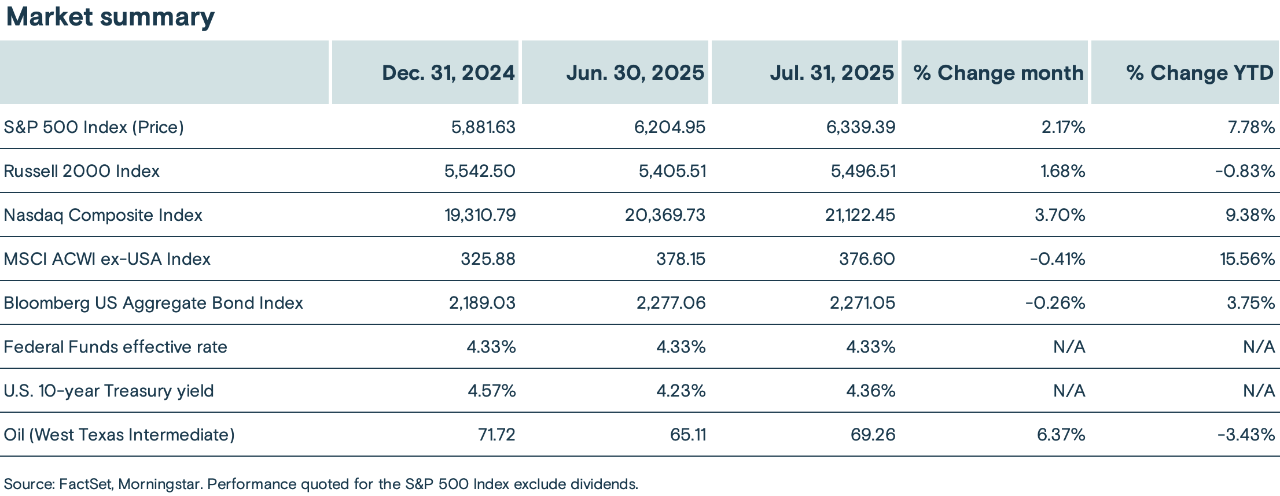
The economy: The economy is slowing, and the most recent employment report is cause for concern, but we continue to caution investors against over extrapolating long-term trends from short-term data, particularly given the distortions that recent policy uncertainty may be creating. We maintain our view that a recession is unlikely as the economy should find support in strong corporate earnings, a low unemployment rate, tax cuts, an expansionary fiscal policy and a supportive wealth effect from strong stock markets and continued increases (though the rate has slowed) in home prices. Tariff policy remains uncertain and is likely to result in a moderate drag on growth, but the market has become accustomed to the idea of tariffs and may have already factored in the risks to growth and inflation they create.
Stocks: We maintain a modest overweight to equities over fixed income given our structurally positive long-term outlook for the economy and our bias toward prioritizing economic fundamentals and corporate earnings as the primary determinant of investment returns over the long term. But we caution that shorter-term volatility is likely to persist, whether due to ongoing policy uncertainty, increasingly expensive valuations or simply the volatility in economic data which comes with turning points in the economy.
Bonds: The outlook for Treasury yields is complicated by the high levels of uncertainty around expected economic growth, the path of inflation, the strength of the U.S. dollar and the U.S. fiscal deficit’s impact on both the supply of and demand for Treasuries. We expect Treasury yields to remain volatile with the risks skewed to further yield increases in long-term bonds and thus favor shorter-duration securities in the Treasury market.
Second-quarter GDP rose at an annual rate of 3.0%, above consensus expectations near 2.6%, supported by an increase in consumer spending (up 1.4% compared to 0.5% in the first quarter) and a decrease in imports which fell 30.3%, nearly reversing the 37.9% growth in imports in the first quarter. While second-quarter growth was a strong rebound from the first quarter’s contraction, growth for the first half of 2025 averaged just 1.25%, a full percentage point lower than the first half of 2024.
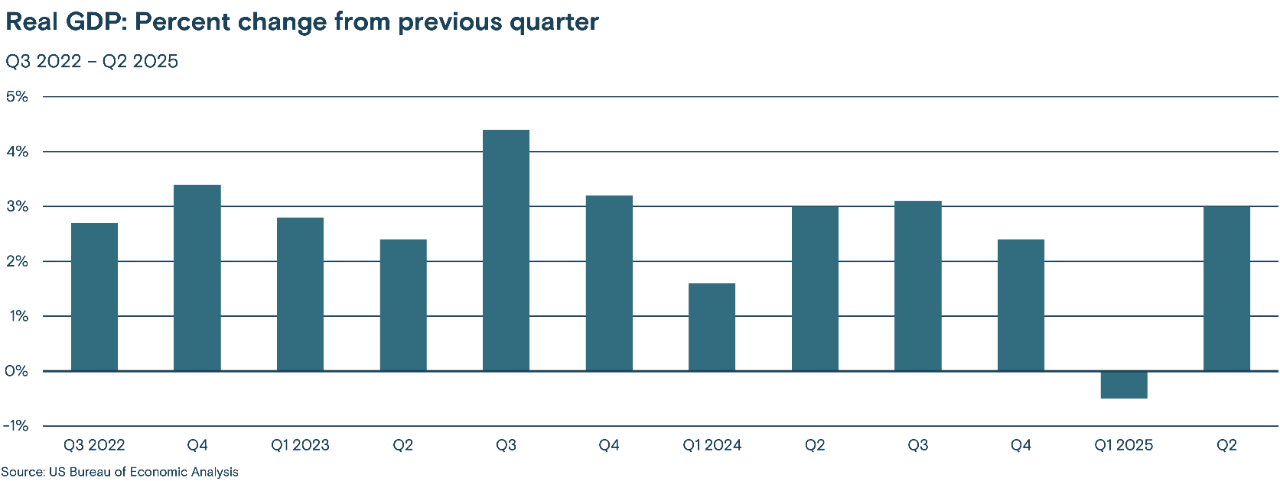
U.S. retail sales rose 0.6% in June after falling in the prior two months. The rise was well above consensus expectations and broad-based, with 10 of the 13 categories in the report showing increases in sales.
The New York Fed’s monthly survey of consumer expectations was also encouraging, showing expectations for inflation over the next year have returned to the levels expected before April’s tariff announcements, near 3%. Additionally, the survey also revealed less concern about personal finances, with fewer households having difficulty finding credit and the likelihood a household would miss a debt payment dropping to levels not seen since May of 2024.
July’s employment report showed 73,000 new jobs were created during the month, well below expectations, and the unemployment rate rose to 4.2% from 4.1% in June. However, it was the downward revisions to new jobs created in the prior two months that surprised markets. May and June’s estimates were reduced by a combined 258,000, bringing the three-month average payroll gain between May and July to just 35,000 jobs added per month. Markets were swift to react to the disappointing news, but as the days passed more investors began to consider the complicating factors which may have created such significant revisions, including seasonal factors and the steady decline in households responding to employment surveys.
June’s Consumer Price Index (CPI) rose 2.7% relative to June 2024, in line with expectations. While most forecasters expected somewhat higher inflation as the effect of tariffs trickled through the economy, Core CPI (which excludes the more volatile food and energy sectors) increased 0.2% over May’s figures, slightly below expectations, and 2.9% relative to last June.
June’s Personal Consumption Expenditures (PCE) Price Index rose 0.3% from May, and 2.6% from last June, higher than consensus expectations which were looking for a 2.5% rise. Core PCE, which is the Fed’s preferred inflation measure, rose 2.8% relative to last year, higher than consensus expectations near 2.7%.
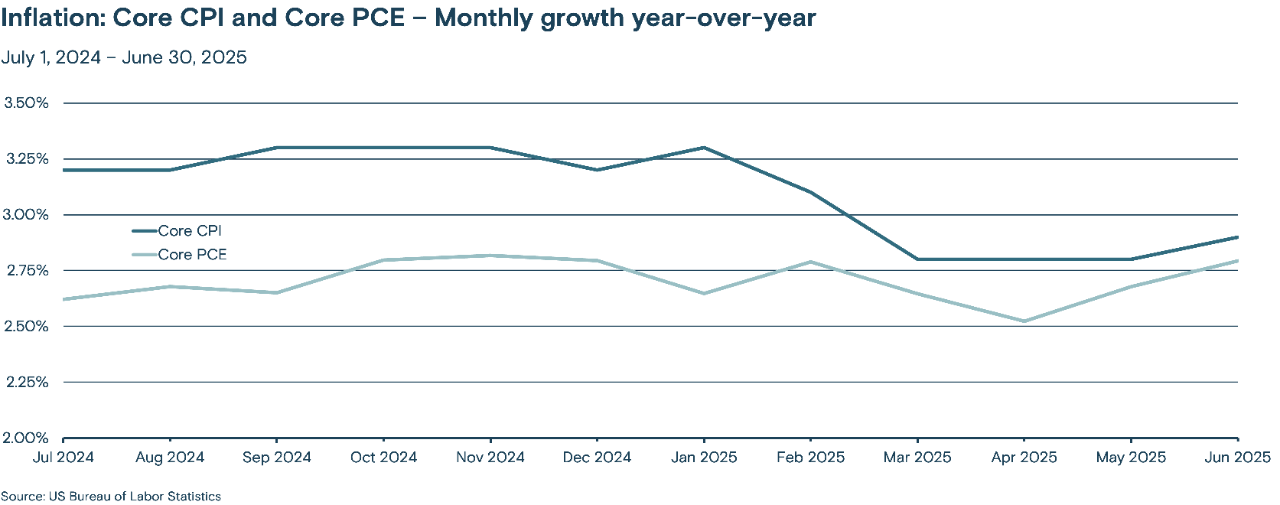
RELATED CONTENT
RELATED ARTICLE
2025 midyear outlook: Living with volatility
We don’t anticipate the market roller coaster will get less bumpy in the second half of 2025.
RELATED PODCAST
Will market volatility persist through the rest of 2025?
U.S. stocks rose in July, with the benchmark S&P 500 Index of large-cap stocks increasing 2.17%, the benchmark Russell 2000 Index of small-cap stocks rising 1.68% and the technology-heavy NASDAQ rising 3.7%. Over the period, the S&P 500 Index set 10 new record highs and ended the month up 7.78% year to date. Second-quarter earnings helped push the market higher, with about 80% of companies in the S&P 500 Index beating consensus earnings and revenue growth expectations. The technology sector again led the index, rising 5.19% in July. Performance in the remaining 10 sectors was more mixed, with half rising and the other half falling. Utilities (up 4.94%) was a notable outperformer, while health care and consumer staples were notably weak, down 3.26% and 2.37%, respectively.

The table below shows the past month and year-to-date performance results of the 11 sectors:

The MSCI ACWI ex-USA Index, which tracks stocks across developed and emerging-market economies across the world (excluding the U.S.), fell 0.41% in July, significantly underperforming the major U.S. equity benchmarks. A stronger U.S. dollar contributed to the underperformance. Asian stocks generally performed well, but European equities were weighed down by concerns over trade policy and its effect on the region’s economic outlook, and GDP in the U.K. contracted for the second month in a row.
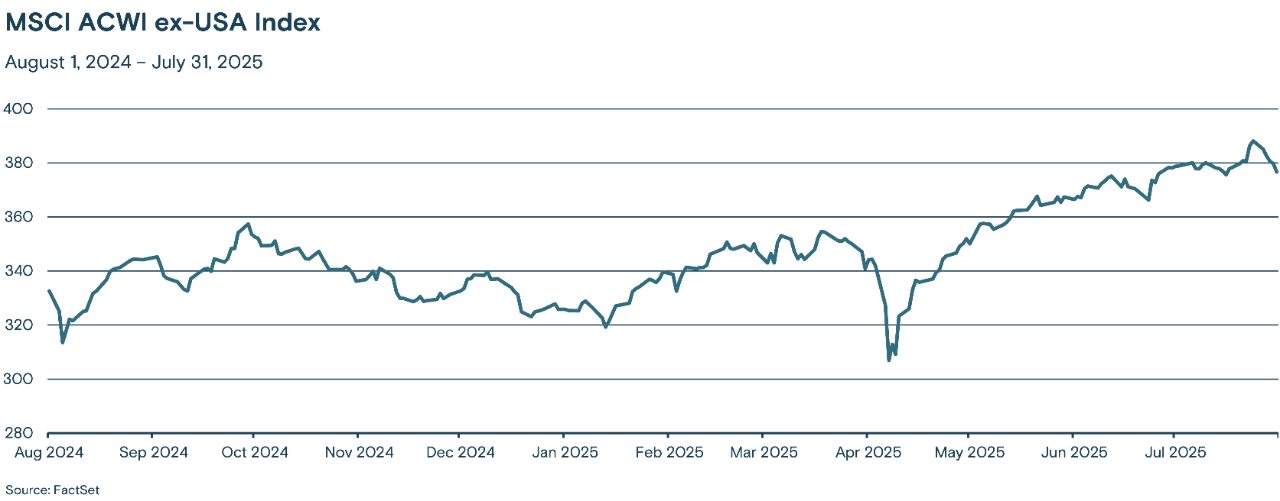
Treasury yields were less volatile in July, but the benchmark 10-year Treasury ended the month yielding 4.36%, 0.13% higher than at the end of June. More constructive economic data and higher inflation contributed to the rise in yields, as did ongoing concerns over the U.S. government budget deficit and the resulting increases in Treasury supply. In early August, the nonpartisan Congressional Budget Office reported that the spending bill approved by Congress in July would add $4.1 trillion to the U.S. deficit over the next decade, including $718 billion of additional debt service costs.
The Fed kept policy rates unchanged at its July meeting. Chairman Jerome Powell remarked after the announcement that “There are many, many uncertainties left to resolve.” The markets seemed to agree, pricing in lower expectations for interest rate cuts at the Fed’s next meeting in September.
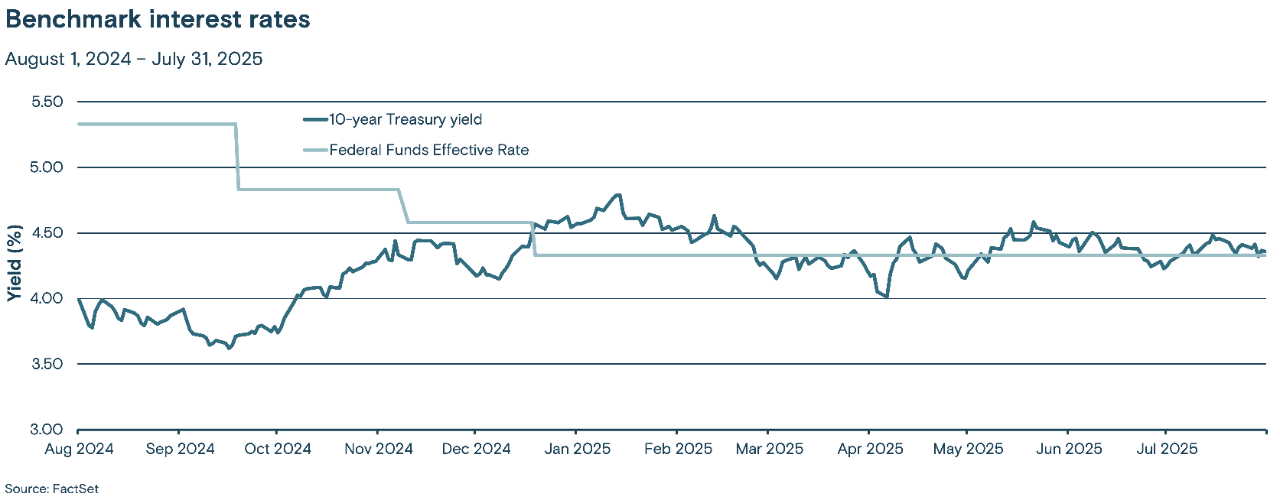
Investment-grade corporate bonds ended the month with slightly narrower spreads (the yield paid over comparable U.S. Treasuries), due to a more optimistic outlook for corporate earnings and strong investor demand for fixed income. However, absolute yields followed Treasury yields higher, and the Bloomberg U.S. Aggregate Bond Index fell 0.26% in July, reducing its year-to-date gain to 3.75%.
The Nominal Trade-Weighted U.S. Dollar Index saw some stabilization in July after a steady decline since the start of the year. The index rose 0.49% in July, cutting its year-to-date decline to -7.01%. Support for the U.S. dollar came from broad-based improvement in investor sentiment, largely due to a decline in tariff-related uncertainty. Additionally, higher-than-expected inflation data supported the U.S. dollar insofar as it could result in interest rates remaining higher for longer.
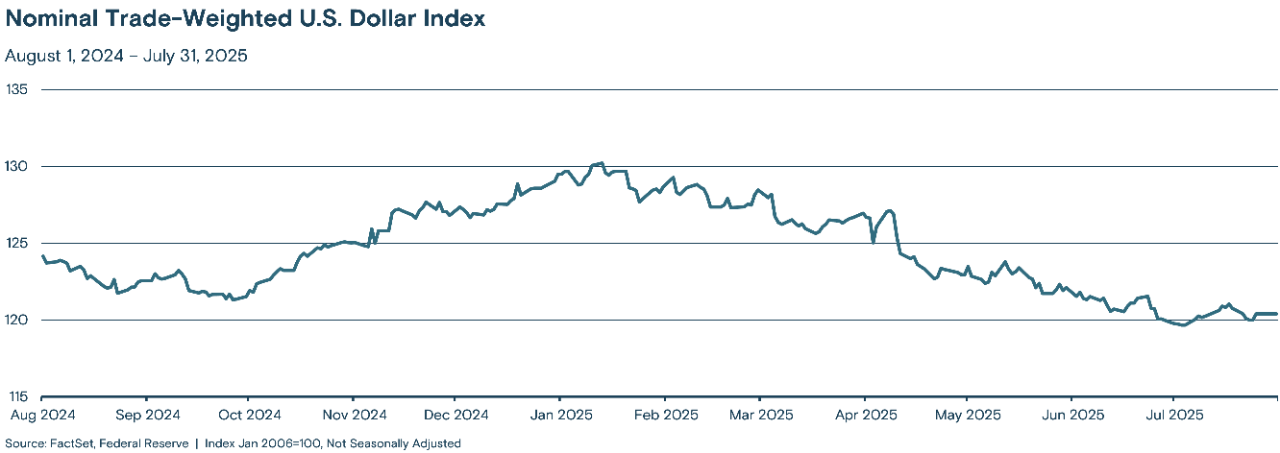
The S&P GSCI Index (a broad-based and production-weighted index representing the global commodity market) rose 2.00% in July, pushing the index’s year-to-date return back into positive territory, at 0.79%. Oil prices continued to recover from their May lows, in part due to concerns about tariffs on countries importing Russian oil will reduce supply. A barrel of West Texas Intermediate (a grade of crude oil used as a benchmark in oil pricing) rose 6.37% over the month. Gasoline prices at the pump fell over the period, with the national average down 2.76% to $3.25 a gallon. Copper prices saw a sharp decline at the end of the month after President Donald Trump announced a 50% tariff on copper imports.

Media contact: Callie Briese, 612-844-7340; callie.briese@thrivent.com
All information and representations herein are as of 08/07/2025, unless otherwise noted.
The views expressed are as of the date given, may change as market or other conditions change, and may differ from views expressed by other Thrivent Asset Management, LLC associates. Actual investment decisions made by Thrivent Asset Management, LLC will not necessarily reflect the views expressed. This information should not be considered investment advice or a recommendation of any particular security, strategy or product. Investment decisions should always be made based on an investor's specific financial needs, objectives, goals, time horizon, and risk tolerance.
This article refers to specific securities which Thrivent Mutual Funds may own. A complete listing of the holdings for each of the Thrivent Mutual Funds is available on thriventfunds.com.
The S&P 500® Index is a market-cap weighted index that represents the average performance of a group of 500 large-capitalization stocks.
The Russell 2000® Index is an unmanaged index considered representative of small-cap stocks.
The Nasdaq Composite Index is a stock market index that includes almost all stocks listed on the Nasdaq stock exchange. The Nasdaq – National Association of Securities Dealers Automated Quotations – is an electronic stock exchange with more than 3,300 company listings.
The MSCI ACWI ex-USA Index is an unmanaged index considered representative of large- and mid-cap stocks across developed and emerging markets, excluding the U.S.
The Bloomberg U.S. Aggregate Bond Index is an unmanaged index considered representative of the U.S. investment-grade, fixed-rate bond market.
The Federal Funds effective rate is the interest rate at which depository institutions (mainly banks) lend reserve balances to other depository institutions overnight on an uncollateralized basis. In simpler terms, it's the rate banks charge each other for short-term loans to meet their reserve requirements.
The Consumer Confidence Index (CCI) is a survey administered by the Conference Board. The CCI measures what consumers are feeling about their expected financial situation, whether that's optimistic or pessimistic.
The University of Michigan Consumer Sentiment Index is a consumer confidence index published monthly by the University of Michigan.
The Consumer Price Index measures the monthly change in prices paid by U.S. consumers for a basket of goods and services.
The Core Consumer Price Index (CPI) measures changes in the prices of goods and services, with the exclusion of food and energy.
The Personal Consumption Expenditures (PCE) Price Index, also known as consumer spending, is a measure of the spending on goods and services by people of the U.S.
The Core Personal Consumption Expenditures (PCE) Price Index, also known as consumer spending, is a measure of the spending on goods and services, excluding food and energy prices, by people of the U.S.
The Nominal Trade-weighted U.S. Dollar Index measures the value of the U.S. dollar based on its competitiveness versus trading partners.
The Institute for Supply Management Purchasing Managers Index (PMI) measures the month-over-month change in economic activity within the manufacturing sector.
Any indexes shown are unmanaged and do not reflect the typical costs of investing. Investors cannot invest directly in an index.
Past performance is not necessarily indicative of future results.